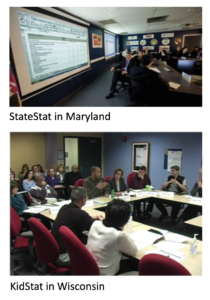 QUICK SUMMARY
QUICK SUMMARY
PerformanceStat is a leadership strategy that uses ongoing, data-driven conversations between top leadership and senior division managers to identify and address important organizational challenges. Examples include CitiStat in Baltimore, StateStat in Maryland, and dozens of other examples at the federal, state and local levels.
 VIDEO OVERVIEWS
VIDEO OVERVIEWS
 STRATEGY DETAILS
STRATEGY DETAILS
Q1. What is PerformanceStat?
PerformanceStat is a leadership strategy that uses ongoing, data-driven conversations between top leadership and senior division managers to identify and address important organizational challenges. Robert Behn of the Harvard Kennedy School coined the term "PerformanceStat" to encompass the approach.
 There are dozens of examples of current and former PerformanceStat initiatives at different levels of government across the U.S., including HUDStat and FEMAStat at the federal level, StateStat in Maryland (top picture), CStat at the Colorado Department of Human Services, KidStat at the Wisconsin Department of Children and Families (bottom picture), CitiStat in Baltimore and AlexStat in Alexandria, Virginia.
There are dozens of examples of current and former PerformanceStat initiatives at different levels of government across the U.S., including HUDStat and FEMAStat at the federal level, StateStat in Maryland (top picture), CStat at the Colorado Department of Human Services, KidStat at the Wisconsin Department of Children and Families (bottom picture), CitiStat in Baltimore and AlexStat in Alexandria, Virginia.
Q2. How is PerformanceStat different from traditional leadership check-in meetings?
Most public sector leaders have regular check-in meetings with their division heads, often focused on the hot-button and pressing issues. Organizations that run PerformanceStat meetings have those check-in meetings too, but they add PerformanceStat meetings, which have a different structure, feel and purpose. In particular, PerformanceStat meetings...
- focus on specific high-priority challenges and meetings keeps coming back to those challenges until they are fixed.
- are very data-driven, using performance metrics to help track problems, successes, and improvements.
- emphasize accountability, including starting meetings with the action items assigned in the previous meeting.
- and have enough staff in the room (including leaders of support functions like finance, operations, HR, IT, and legal) so that many questions can be answered in real time, rather than needing to say, “We’ll check with so and so.”
Q3. Why has the PerformanceStat approach been so valued by those who have championed it?
One reason is that it helps leaders manage divisions, foster a culture of continuous improvement, and make sure everyone in the organization was rowing in the same direction. In the words of Reggie Bicha, who launched and led both KidStat in Wisconsin and CStat in Colorado:
"The number one thing for me, I think, was alignment -- that as, the secretary of the department...I am worried about, "Do I have the right staff with the right resources, delivering the right programs at the right time to the right people, that's going to help our state achieve what it is that I've been assigned by the legislature and the governor to achieve?" And what KidStat provided me was that sense of alignment. We could track -- and did track -- what were the key priorities...[of the department]. And the alignment of knowing that I was looking at the same data that my bureau directors were looking at, and they were looking at the same data that their supervisors were looking at it..."
Q4. What occurs during PerformanceStat meetings?
As noted above, meetings start with the action items assigned in the last meeting, to ensure accountability and maintain a focus on action. The rest of the meeting is likely to be a data-driven conversation on what was working, what wasn’t, why something wasn’t working and how to fix it. That could involve a presentation by a division leader, standing next to screens showing the data. Or maybe the PerformanceStat team reviews the performance metrics with the group to kick off the discussion. Either way, it is not a passive process. Leadership is likely to interrupt any presentations quickly to press with questions: "What do we know about this trend?", "Why is your assumption based on?", "What is the bottleneck?" In other words, successful Stat meetings do not look or feel like show-and-tell, but rather like a leadership-driven process.
Q5. What occurs between meetings?
Much of the work accomplished by a PerformanceStat initiative occurs between meetings, focused on the action items determined in the meeting. For example, at the Wisconsin Department of Children and Families, the KidStat process highlighted the fact that the agency was not achieving its goal of having 100% of children who enter the foster care system be seen by a doctor within a week of entering the system. Between meetings, the division overseeing the process worked to determine how more doctors could be added to the system and how other process improvements might help. Within a few PerformanceStat meetings -- and because of the work done between meetings -- the agency was able to achieve its 100% target rate.
Some of the work between meetings (and action items) is also likely to be around data issues, such as working to improve data quality or tracking down additional data. Importantly, Stat processes can launch with just a small set of performance metrics, but over time the data can be refined and expanded as needed.
Q6. What are some choices in structuring a PerformanceStat initiative?
- How to organize the meetings: PerformanceStat meetings can be focused on sub-units, such as departments (for a state, city or county) or divisions (if it's an agency). Alternatively, the meetings can focus on priority goals. In the latter case, the participants will likely span organizational boundaries. For example, as Martin O'Malley and Andrew Feldman point out, "In Baltimore's CitiStat, each meeting focused on a different city agency. When O'Malley become governor and launched a state version of CitiStat, he saw that many of the state's key challenges overlapped multiple agencies. So he structured some StateStat meetings around priority goals, not departments. An example was BayStat, which focused on improving the health of the Chesapeake Bay."
- No surprises vs. be ready for anything: In some PerformanceStat initiatives, the Stat team (after meeting with leadership) will send the division or agency that's the focus of the meeting is given the questions ahead of time that leadership will ask -- i.e., the "no surpasses" version. That has the advantage of giving the presenters a chance to prepare and emphasizes collegiality. In other Stat initiatives, the Stat team and leadership work prepare questions before each meeting, but don't share them with the presenters. That has the advantage of forcing presenters -- say, division or agency leaders -- to be on top of their game, in terms of knowing about the causes, trends and progress being made around key challenges. The right approach depends on the organization and its culture.
- Creation of ad-hoc tiger teams: In some cases, issues arise that are more complicated than a regular Stat process is meant to handle. When that happens, the executive could assign an ad-hoc team to focus on that issue. For example, in Louisville, Kentucky under Mayor Greg Fischer, when issues arise within LouieStat that require focused attention from issue experts, cross-functional problem-solving teams spend a few months diagnosing and trying to solve them. For example, one team "focused on reducing ambulance turnout times, meaning the time from patient drop-off at the hospital to the next run. In just four months, the team's work resulted in efficiency gains worth $1.5 million a year, equivalent to two extra ambulances in service."
Q7. What is senior leadership's role in PerformanceStat?
Senior leadership's role is crucial. In fact, PerformanceStat initiatives work best -- and are most impactful -- when everyone in the organization views the initiative as the main way that leadership manages the organization. That means the chief executive (governor, mayor, agency secretary, etc.) or their deputy is ideally in the room for most Stat meetings and active participants, if not leading the meetings. For example, to underscore CStat's importance within the Colorado Department of Human Services, Reggie Bicha almost never missed a CStat meeting during his more than seven years as director.
Q8. What are common misconceptions about PerformanceStat?
As Martin O'Malley and Andrew Feldman have noted, "Some people mistakenly see the PerformanceStat approach as a 'firing squad' for bad employees. It’s actually a way to shine a spotlight on your most effective leaders. By lifting up their examples and sharing approaches and strategies that work well, it encourages others across the organization to emulate their example. Moreover, by setting public goals with deadlines and tracking them in subsequent PerformanceStat meetings, it gives urgency and clarity to issues that the jurisdiction’s ultimate bosses—the citizens—care about most."
Q9. What does it take to launch PerformanceStat?
A PerformanceStat initiative can start small, with one or more pilot divisions or priority goals. A PerformanceStat team of analysts can work to gather existing performance data from divisions and work with leadership and staff to pick focal topics for the first meeting. A piece of advice from almost every executive that has run Stat processes is "start with the data you have and work from there." Nor is fancy technology needed -- a basic spreadsheet program can be the heart of the data analysis. The one essential element of the process -- the thing that it won't work without -- is leadership commitment and involvement.
Q10. What another example of results produced by PerformanceStat?
When the U.S. Treasury secretary in the Obama administration decided to launch "TreasuryStat," he tasked his deputy secretary, Neal Wolin, to launch and lead it. Wolin was at first wary, seeing it as just another set of meetings in a calendar already full of meetings. Within a few months, however, his views changed when he realized it was the only time during the week that he was able to focus on the most important issues facing the department. TreasuryStat would help drive important reforms, including moving federal benefits, such as Social Security, from paper checks to electronic. That reform alone saved the department more than $100 million a year.
 ADDITIONAL RESOURCES
ADDITIONAL RESOURCES
- Articles:
- "Caught in the Cycle of ‘Urgent Over Important’? This Leadership Strategy Can Help" by Martin O'Malley and Andrew Feldman in Route 50.
- "PerformanceStat: A Leadership Strategy That Keeps Innovating" by Michael Jacobson, Melissa Wavelet, and Andrew Feldman in Governing.
- "The Seven Big Errors of PerformanceStat" and "PerformanceStat Leadership Strategy" by Robert Behn, published by the Harvard Kennedy School.
- Briefing memo: "PerformanceStat," by Andrew Feldman.
- Books:
- Smarter Government by Martin O'Malley. The book includes chapters with advice on running PerformanceStat programs from the elected official who first brought the approach to city and then state government.
- The PerformanceStat Potential by Robert Behn. The book provides an in-depth examination of this strategy.
- Gov Innovator podcast interviews:
- Insights from C-Stat in Colorado at year 5: Reggie Bicha, Colorado Department of Human Services
- Strengthening a culture of data-driven decision making: Carter Hewgley, Federal Emergency Management Agency (FEMA)
- Using “C-Stat” in Colorado to drive results-focused human services: Ki’i Powell, Colorado Department of Human Services
- Louisville’s performance initiatives, including LouieStat, at year three: Theresa Reno-Weber, City of Louisville, Kentucky
- Focusing a social service agency on results and improved outcomes [through KidStat]: Reggie Bicha, Colorado Department of Human Services
- Local perspectives on PerformanceStat: David Gottesman, Montgomery County, Maryland, and Greg Useem, City of Alexandria, Virginia
- Using LouieStat and collaboration across agencies to improve results in Louisville: Theresa Reno-Weber, City of Louisville, Kentucky
- The PerformanceStat Potential: Bob Behn, Harvard Kennedy School
- The Governor’s Delivery Unit in Maryland: Mike Powell, State of Maryland
- Boosting results through HUDStat: Lisa Danzig, U.S. Department of Housing and Urban Development
- Creating results-focused city government through SomerStat: Joseph Curtatone, Mayor of Somerville, Massachusetts
- Maryland’s StateStat initiative: Beth Blauer, State of Maryland
 CUSTOMIZED ASSISTANCE
CUSTOMIZED ASSISTANCE
Please contact us if your organization needs assistance in designing and implementing a PerformanceStat approach.
![]() PDF VERSION OF THIS PAGE (click here)
PDF VERSION OF THIS PAGE (click here)
